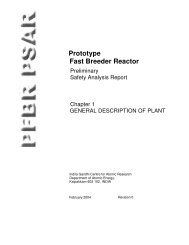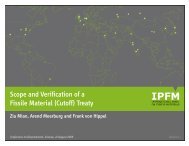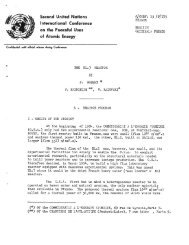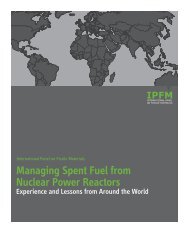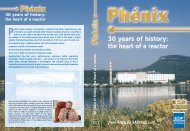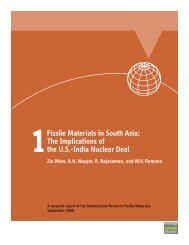Nuclear Proliferation TechnologyTrends Analysis - International ...
Nuclear Proliferation TechnologyTrends Analysis - International ...
Nuclear Proliferation TechnologyTrends Analysis - International ...
Create successful ePaper yourself
Turn your PDF publications into a flip-book with our unique Google optimized e-Paper software.
PNNL -14480<br />
Chemex, the chemical exchange process developed by the French, uses the exchange<br />
reaction that takes place between two valence states (U 3+ and U 4+ ) of uranium ions in<br />
aqueous solution. Isotopic enrichment results from the tendency of 238 U to concentrate in<br />
the U 3+ compound while 235 U concentrates in the U 4+ compound. It is therefore possible<br />
to obtain enriched uranium by removing the U 4+ compounds with an organic solvent that<br />
is immiscible with the aqueous phase (concentrated hydrochloric acid). Several possible<br />
extractants are available; however tributyl phosphate (TBP) is typically used. TBP is<br />
diluted with an aromatic solvent, and this organic phase moves countercurrent to the<br />
aqueous phase through a series of pulsed columns.<br />
In the pulse column, the heavier aqueous phase is fed into the top of the column and the<br />
lighter organic phase is fed into the bottom of the column. A rapid reciprocating motion<br />
(pulsing) is applied to the contents of the column, providing efficient and intimate contact<br />
of the two phases.<br />
After passing through the column, the enriched and depleted uranium streams must be<br />
chemically treated to be re-circulated through the column again (refluxed) or sent to<br />
another column for additional enrichment. This requires complicated refluxing<br />
equipment at both ends of the column.<br />
3.4.1.2.2 Ion-exchange<br />
The ion-exchange process developed by the Japanese (the Ashai Chemical Exchange<br />
Process, ACEP) uses the chemical isotope effect between two valences (U 4+ and U 6+ ) of<br />
uranium. In this process, the organic phase is replaced by a proprietary ion-exchange<br />
resin. The aqueous phase flows through the stationary resin held in a column and the net<br />
effect of all the chemical reactions is a “band” of uranium that moves through the ionexchange<br />
column. The exchange between the unadsorbed uranium flowing through the<br />
band and that adsorbed on the resin enhances the isotopic separation. In this continuous<br />
separation system, 235 U and 238 U tend to accumulate respectively at the entrance and exit<br />
ends of the adsorption band. In this process, it is economical to regenerate many of the<br />
chemicals by reaction with oxygen and hydrogen in separate equipment.<br />
The adsorbent in the columns is a spherical bead of porous anion-exchange resin with<br />
both a very high separation efficiency and exchange rate. The development and<br />
manufacture of the appropriate adsorbent beads has required years of experimental<br />
research and development.<br />
3.4.1.3 Important components/materials<br />
Components and materials necessary to develop a chemical or ion-exchange enrichment<br />
plant include:<br />
• Liquid-liquid exchange columns<br />
• Liquid-liquid centrifugal contactors<br />
• Electrochemical reduction systems and reduction cells<br />
42



